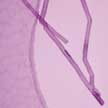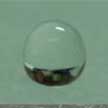Showing Spotlights 601 - 608 of 631 in category All (newest first):
 With the recent development in nanoscience and nanotechnology, a large variety of single-component nanomaterials (such as carbon nanotubes, nanoparticles, and quantum dots) and devices have been reported. There is now a pressing need to integrate multicomponent nanoscale entities into multifunctional systems and to connect these nano-systems to the micro/macro-world. This connection from the nano world to the macro world has been one of the long-standing problems in nanotechnology and still remains a big challenge. A novel approach of growing aligned carbon nanotubes (CNTs) around microsized carbon fibers should provide a useful platform technology for the development of various multidimensional and multifunctional nanomaterials and devices.
With the recent development in nanoscience and nanotechnology, a large variety of single-component nanomaterials (such as carbon nanotubes, nanoparticles, and quantum dots) and devices have been reported. There is now a pressing need to integrate multicomponent nanoscale entities into multifunctional systems and to connect these nano-systems to the micro/macro-world. This connection from the nano world to the macro world has been one of the long-standing problems in nanotechnology and still remains a big challenge. A novel approach of growing aligned carbon nanotubes (CNTs) around microsized carbon fibers should provide a useful platform technology for the development of various multidimensional and multifunctional nanomaterials and devices.
Aug 11th, 2006
 Researchers in Japan have synthesized novel silica fibers. Unlike any previously reported one-dimensional silica nano- and microstructures, the novel fibers display a triangular cross-section, which is not typical for amorphous materials. These prism-like silica fibers open up a new morphological type of silicon-based materials which may have highly promising potentials. They may be of significant interest for optoelectronic applications and the improvement of SnO2 chemical sensors and catalysts.
Researchers in Japan have synthesized novel silica fibers. Unlike any previously reported one-dimensional silica nano- and microstructures, the novel fibers display a triangular cross-section, which is not typical for amorphous materials. These prism-like silica fibers open up a new morphological type of silicon-based materials which may have highly promising potentials. They may be of significant interest for optoelectronic applications and the improvement of SnO2 chemical sensors and catalysts.
Aug 2nd, 2006
 The fabrication of ultrafine structures beyond the limits of conventional lithography is a topic of tremendous importance and is expected to play a significant role in the realization of futuristic nanotechnology. It is also equally important to develop functional material systems of ultrafine dimensions in order to achieve this goal. An important step towards realization of nanodevices is self-organized nanopatterning of functional structures. A new technique, which might be called chemical lithography, enables the regular assembly of optically active nanoparticles on a silicon surface.
The fabrication of ultrafine structures beyond the limits of conventional lithography is a topic of tremendous importance and is expected to play a significant role in the realization of futuristic nanotechnology. It is also equally important to develop functional material systems of ultrafine dimensions in order to achieve this goal. An important step towards realization of nanodevices is self-organized nanopatterning of functional structures. A new technique, which might be called chemical lithography, enables the regular assembly of optically active nanoparticles on a silicon surface.
Aug 1st, 2006
 Researchers combined two different materials from nature, both of which have unique and important properties, into one material system via genetic engineering. By combining the features of silk with biosilica through the design, synthesis, and characterization of a novel family of chimeric proteins an innovative biomimetic nanocomposite was fabricated.
Researchers combined two different materials from nature, both of which have unique and important properties, into one material system via genetic engineering. By combining the features of silk with biosilica through the design, synthesis, and characterization of a novel family of chimeric proteins an innovative biomimetic nanocomposite was fabricated.
Jul 27th, 2006
 A new method based on the nanoscale Kirkendall effect was demonstrated to fabricate compound nanotubes. Through a spinel-forming solid-state reaction, high aspect-ratio core-shell ZnO-Al2O3 nanowires transform into monocrystalline ZnAl2O4 nanotubes.
A new method based on the nanoscale Kirkendall effect was demonstrated to fabricate compound nanotubes. Through a spinel-forming solid-state reaction, high aspect-ratio core-shell ZnO-Al2O3 nanowires transform into monocrystalline ZnAl2O4 nanotubes.
Jul 14th, 2006
 Researchers at the University of Illinois at Urbana-Champaign have shown that, by employing small pieces of DNA molecules called aptamers, nanomaterials can be smart enough to assemble or disassemble only in the presence of programmable signals such as AND or OR, with controllable cooperativity.
Researchers at the University of Illinois at Urbana-Champaign have shown that, by employing small pieces of DNA molecules called aptamers, nanomaterials can be smart enough to assemble or disassemble only in the presence of programmable signals such as AND or OR, with controllable cooperativity.
Jul 13th, 2006
 In order to survive, biological systems need to form patterns and organize themselves. Scientists at the Max Planck Institute for Colloids and Interfaces (MPI-KG) in Potsdam, Germany, have now combined self-organization with chemical pattern formation. They demonstrated that oscillating reaction patterns like that of a Belousov-Zhabotinsky reaction can not only be generated in a one-phase system like in all previous examples but also in a two-phase system like liquid-solid.
In order to survive, biological systems need to form patterns and organize themselves. Scientists at the Max Planck Institute for Colloids and Interfaces (MPI-KG) in Potsdam, Germany, have now combined self-organization with chemical pattern formation. They demonstrated that oscillating reaction patterns like that of a Belousov-Zhabotinsky reaction can not only be generated in a one-phase system like in all previous examples but also in a two-phase system like liquid-solid.
Jul 12th, 2006
 Superhydrophobic surfaces, such as lotus leaves, with micro/nano combined structures found in nature have attracted a lot of interest because of their importance in fundamental research and practical applications such as self cleaning, anti-fogging/snowing, drag reduction effect etc. In this regard, diverse methods have been proposed to produce such surfaces. However, most of the reported methods in the literature generally require a cleanroom-based process or complex chemical processes and have some limitations in terms of mass-production capability and material selectivity.
Superhydrophobic surfaces, such as lotus leaves, with micro/nano combined structures found in nature have attracted a lot of interest because of their importance in fundamental research and practical applications such as self cleaning, anti-fogging/snowing, drag reduction effect etc. In this regard, diverse methods have been proposed to produce such surfaces. However, most of the reported methods in the literature generally require a cleanroom-based process or complex chemical processes and have some limitations in terms of mass-production capability and material selectivity.
Jul 11th, 2006
 With the recent development in nanoscience and nanotechnology, a large variety of single-component nanomaterials (such as carbon nanotubes, nanoparticles, and quantum dots) and devices have been reported. There is now a pressing need to integrate multicomponent nanoscale entities into multifunctional systems and to connect these nano-systems to the micro/macro-world. This connection from the nano world to the macro world has been one of the long-standing problems in nanotechnology and still remains a big challenge. A novel approach of growing aligned carbon nanotubes (CNTs) around microsized carbon fibers should provide a useful platform technology for the development of various multidimensional and multifunctional nanomaterials and devices.
With the recent development in nanoscience and nanotechnology, a large variety of single-component nanomaterials (such as carbon nanotubes, nanoparticles, and quantum dots) and devices have been reported. There is now a pressing need to integrate multicomponent nanoscale entities into multifunctional systems and to connect these nano-systems to the micro/macro-world. This connection from the nano world to the macro world has been one of the long-standing problems in nanotechnology and still remains a big challenge. A novel approach of growing aligned carbon nanotubes (CNTs) around microsized carbon fibers should provide a useful platform technology for the development of various multidimensional and multifunctional nanomaterials and devices.
 Subscribe to our Nanotechnology Spotlight feed
Subscribe to our Nanotechnology Spotlight feed
